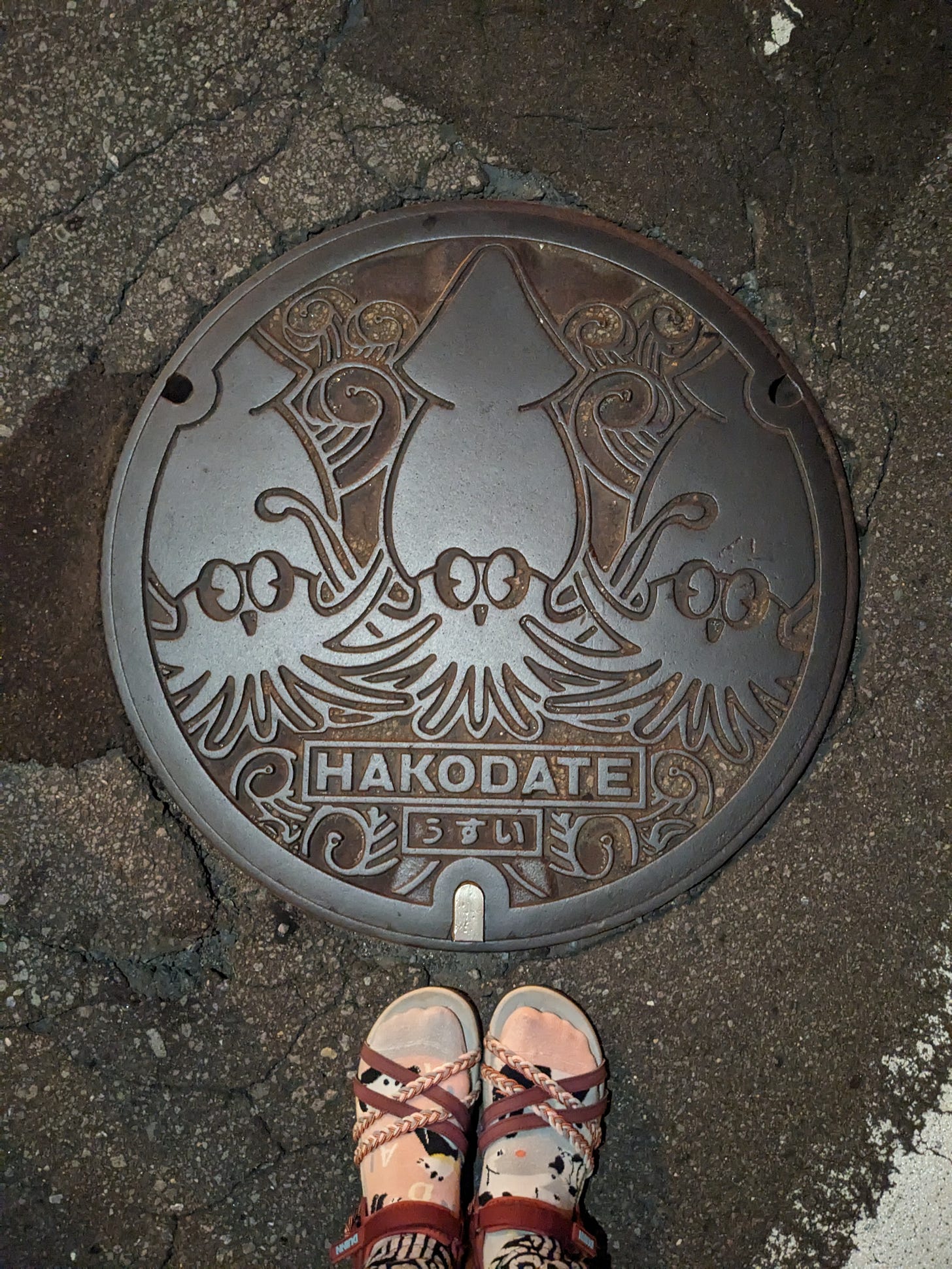I didn’t think the port city of Hakodate was anything special. But I’m about to be very surprised.
We arrive in Hakodate for four nights here, and have the most interesting check-in experience. We talk to a check-in agent in Manila, while we stand outside our apartment. After some questions, we are given the code to the apartment. Our apartment is well located, only a 1-minute walk from the water and a 5-minute walk from the famous Kanemori Red Brick Warehouse district (金森赤レンガ倉庫). It’s all converted red brick buildings from an earlier era, and now it’s a shopping district.
After check-in, we head to the old port area to visit the few still-open restaurants. In the US this area would be open til 10 pm. But since it’s Japan, the shopping district closes at 5 pm. Luckily we find the open burger joint Lucky Pierrot. It is a beloved and quirky fast-food chain unique to Hakodate, Hokkaido. Known for its eclectic, circus-themed decor and oversized portions, Lucky Pierrot has become a local icon and it’s an attraction of its own!
We try the famous Chinese Chicken Burger and Omu rice. Both are good and crazy affordable. Our favorite is taking pictures of all their kitchy decorations though. We love kitch!

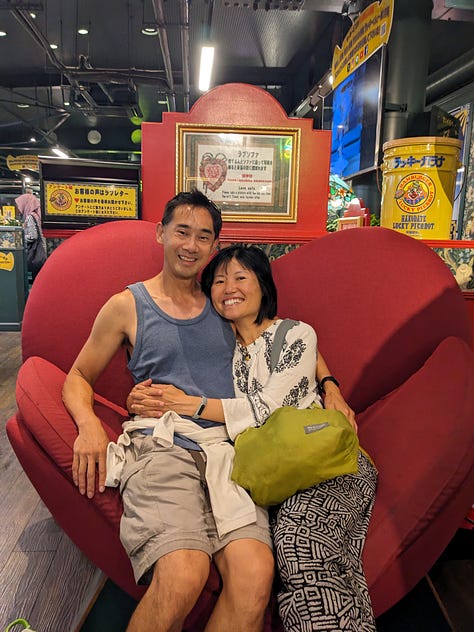


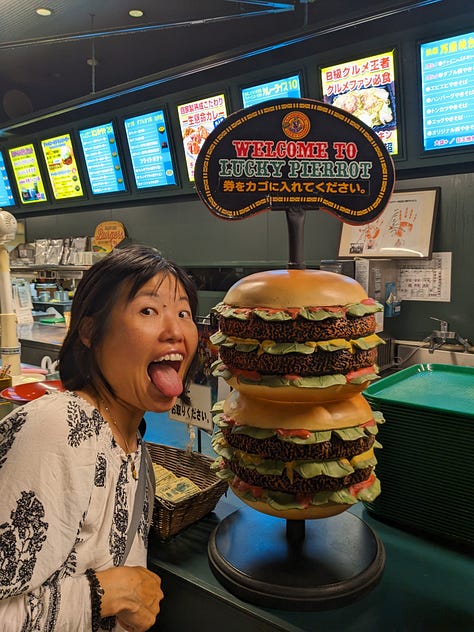
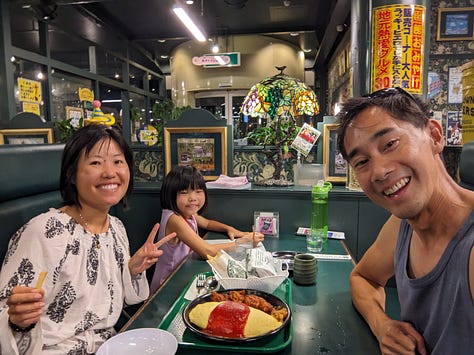
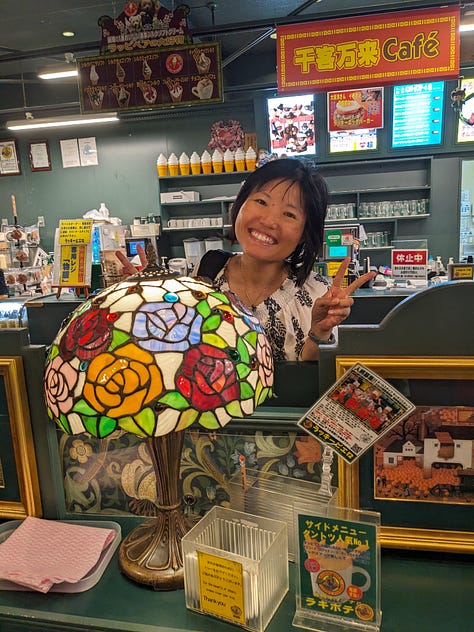
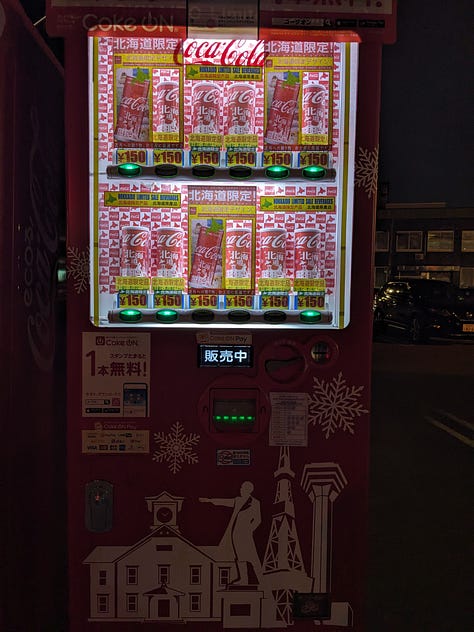
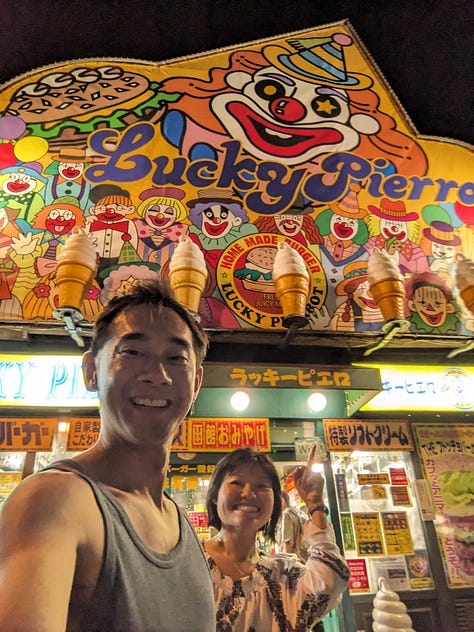
Morning at the Hakodate Asaichi (Morning Market)
The next morning we head to the famous and lively Hakodate Asaichi. And that’s when I fall in love with Hakodate. Long before coming here, in a Hokkaido attraction map, I saw Hakodate mentioned with a photo of a live squid. I thought they have a famous aquarium. Nope there is no aquarium here, Hakodate is actually the city of squid!!!🦑🦑🦑🦑🦑🦑🦑 And you know how I love squid!
I’m a bit torn because Hakodate is famous for catching and eating squid. And while I do love the taste of squid, I also prefer to see them alive and swim with them. You may recall my Birthday Squid post.
Apparently, catching squid in Hakodate is easy due to its ideal location near squid-rich waters in the Tsugaru Strait, where cold and warm currents meet, creating a perfect habitat for squid. The local tradition of night fishing with bright lights attracts squid to the surface, making them easier to catch. Squid fishing is a deeply rooted cultural and economic activity in Hakodate, with skilled fishermen and even tourist experiences like catching squid at the morning market. Additionally, Hakodate is on the migratory route of squid, ensuring large numbers are present during the season.
You heard it right, they have a squad catching activity at the morning market, and we come upon all the signs pointing to it immediately. So we go there to take a look. There’s a huge line of about 1.5 hours. There is one old man doing everything so the line moves very very slowly. You pay 1800 yen ($15) for the 10-second experience of catching the squid.
Then the old man kills it for you and turns it into sashimi. Warning, The video below contains explicit content showing the killing of squid, so you might not want to watch it.
I can’t bear to choose which squid gets to die. I’m no saint, I do eat squid. But somehow choosing which one gets to die now is very hard.
So we skip the squid fishing, and head out to see the rest of the market. I take photos with live swimming squid and stuffed cuddly squid. We find very very large crabs of all varieties and of course a bit of all the other seafood too. But there is an outsized amount of squid being sold here. There are dried squid that are thick cut all the way down to floss cut. You may have heard of pork floss, and now I know there’s squid floss. There’s smoked squid and naturally flattened and roasted squid. There’s a machine that will perform the roasting, flattening, and cutting of the squid in one go. The person loads the squid meat and then catches the result in bags. There’s squid stuffed with rice and cooked, all ready to eat in vacuum packs. We find a few more stands where there is no line at all for the squid-catching experience, but somehow they don’t have advertising, so no one goes to them. I don’t know why they don’t go to the big 1.5 hour lineup and tell them to come to their stand 🤷♀️.
We get lunch at the food court and try some of that stuffed squid. It is delicious. We are finally in the last part of our trip where we can buy stuff to take home. So I buy some vacuum packed to take home.

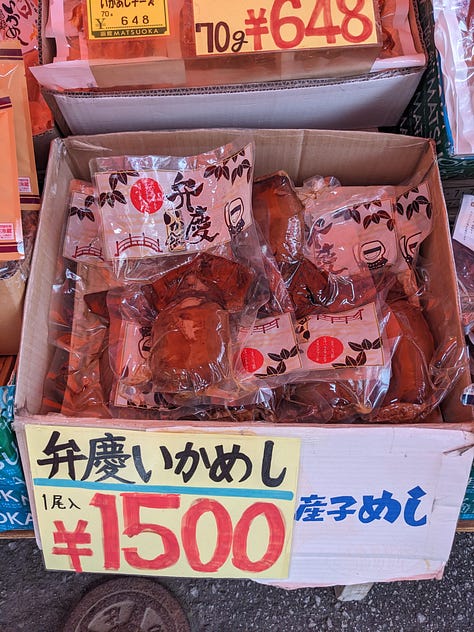
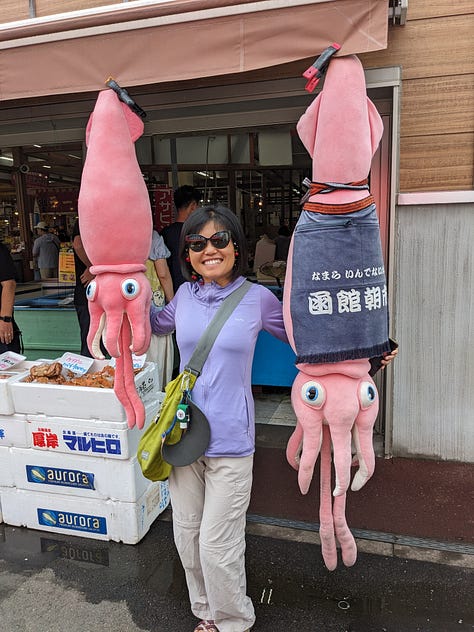
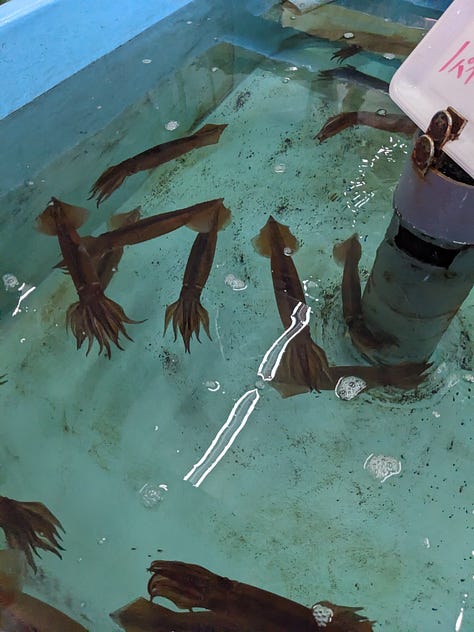
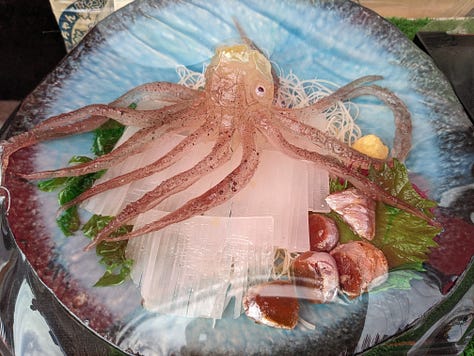

Around the corner from the market, we come across the most amazing restaurant we will visit four times but don’t ever eat at. It’s a seafood restaurant with tanks and tanks of live animals in the front. There are live squid, crabs, octopus, and fish. We find this giant octopus with a clutch of eggs! During our 4 nights in Hakodate we swing by four times to look at the sea creatures. But knowing our visit will be the death of these creatures, we never walked inside.

The Stunning Night View from Mount Hakodate
The night view from Mount Hakodate is famous because the view has ocean on both sides with a strip of land down the middle that expands into the distance. It’s rated one of the top views in Japan, and Papa Bear loves views, so we decide to take the ropeway up to the top for sunset. Turns out 10 other tour busses made the same decision and the place is busy. When we get to the ticket booth, they hold up an English sign saying “There is no view at the top at the moment” and point to the live cam behind them that shows all the fog. This is quite common in Hakodate, the mountains attract fog at sunset, but sometimes it clears up.
So we find a snack nook upstairs and decide to wait it out. There’s no point spending $20US a person to go up to see fog. Fortunately, there are wide windows with a view at their tiny snack area. Unfortunately, there’s a TV in the corner, and it’s playing an advertisement for a specific anime show. on an infinite loop. If we can speak Japanese, I would probably know the song by heart now.

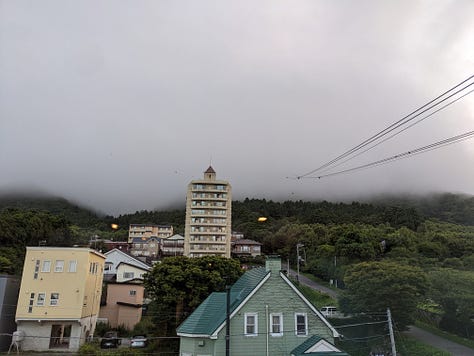

Two hours later and after sunset, the fog never lifted at the top. So we never went up. But we enjoy the view from the snack area windows and feel that we are lucky to be here anyway. Hungry and tired, we head out to find some dinner on the way home.
Shopping Hakodate Kanemori Red Brick Warehouse district (金森赤レンガ倉庫)
Next day we head to the fort again during daylight hours for some shopping. But first, a stop at a nearby curry place. Hakodate curry is quite special and has its own local variation known as Hakodate curry rice. The dish is inspired by Western-style curry, which became popular in Japan during the Meiji era when Hakodate was one of the first Japanese cities to open to foreign trade. It has a milder flavor and often incorporates seafood. But the curry shop we visit has a very simple menu and we order 2 out of the 3 thing on offer - chicken curry and beef curry. The place has a cute bookstore vibe, with books available for reading, a game or two, and a stack of children’s paper bibs. So we all wear one. Both curries are delicious.
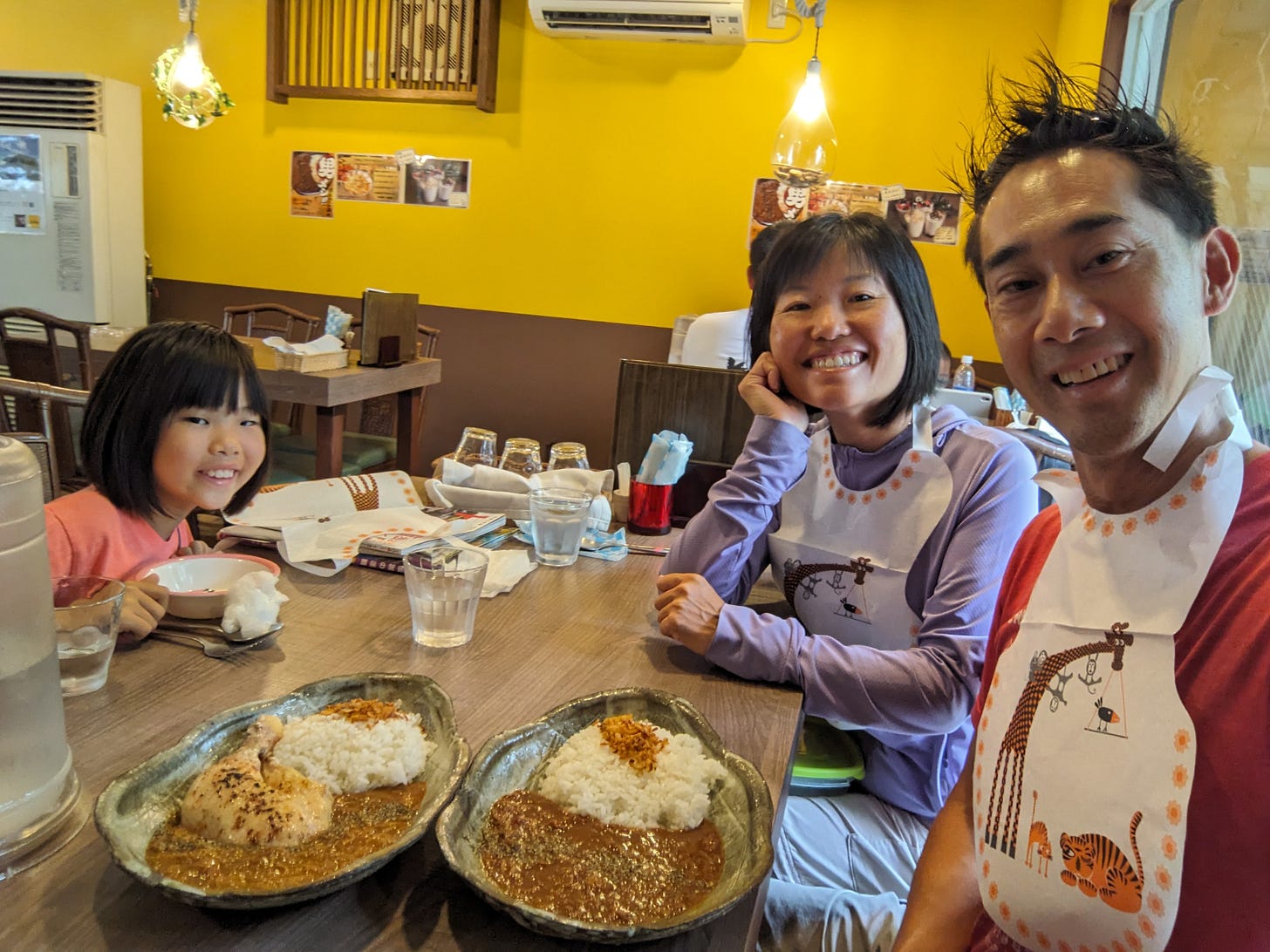
Then it’s off to shopping we go, walking through five or so red-brick buildings that line the waterfront. Buildings that used to be ship repair shops, storage and likely canneries.
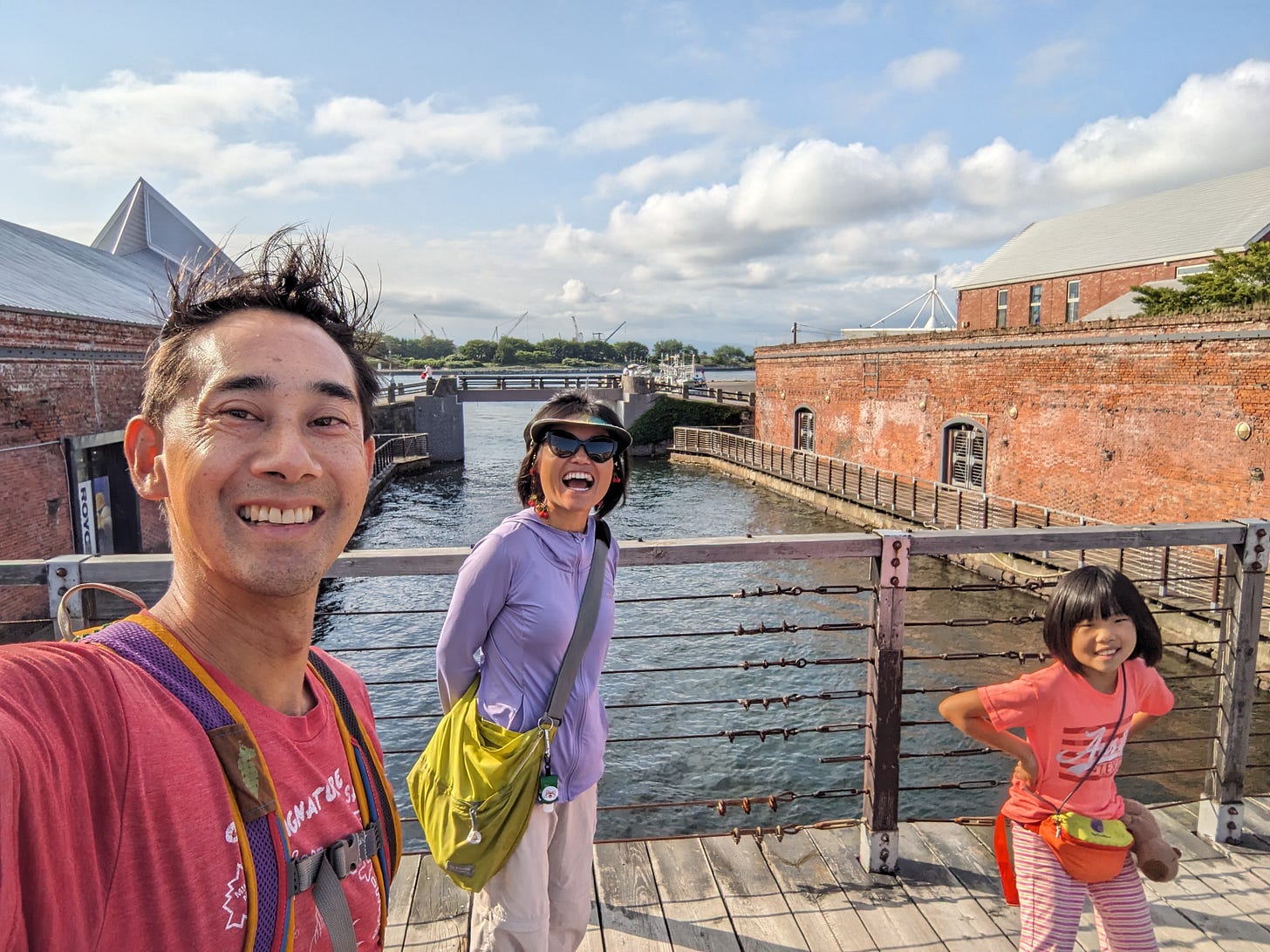
Inside we find a store with beautiful and intricate glass “creatures” including our favorites, squid, of course, it is Hakodate, and nudibranch, rays, garden eels, octopus, electric eel and the Shima Enaga (シマエナガ), a bird that is in every souvenir shop in Hakodate because it is a cute white snowball of a bird. It’s so cute that even though we have never seen an actual one, we are enticed into buying souvenirs of them already from day one.
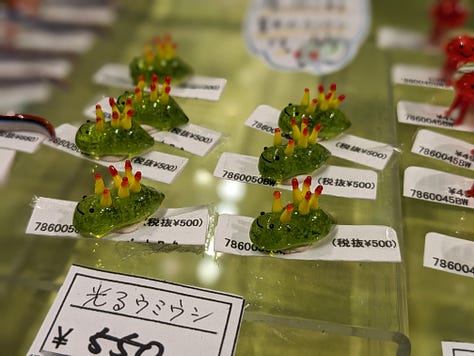

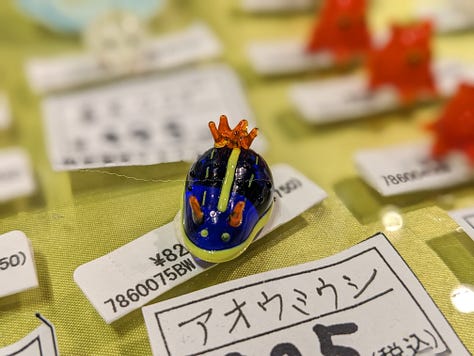
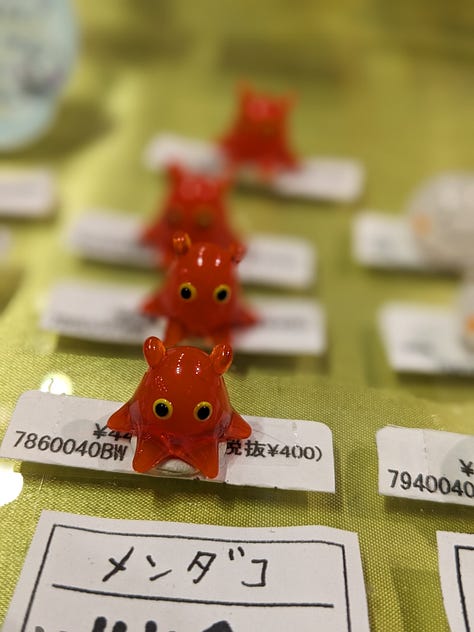

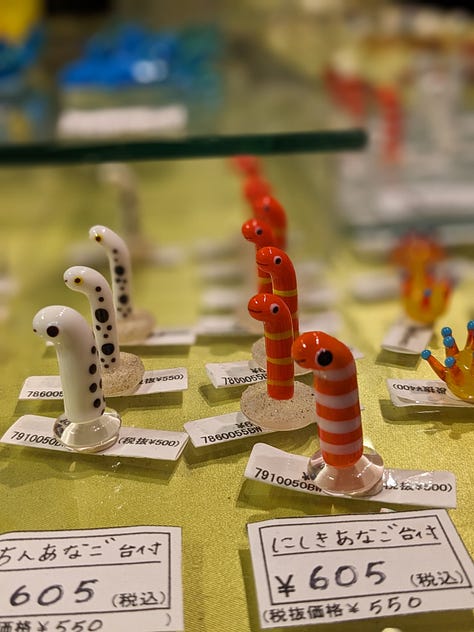
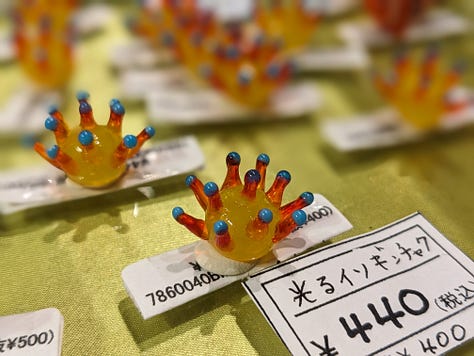


I’m on the hunt for a souvenir with squid on it that I love. We take pictures with all the cute things. Eventually we end up at a seafood market, and find their giant king crab, giant octpus leg, and more life squid in tanks that you can buy as sashimi.

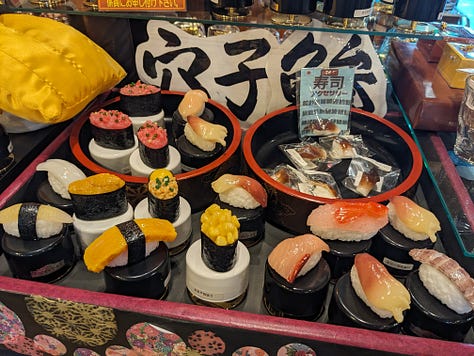
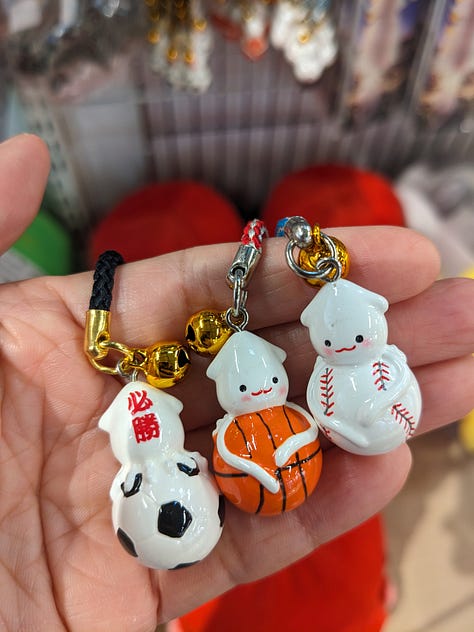

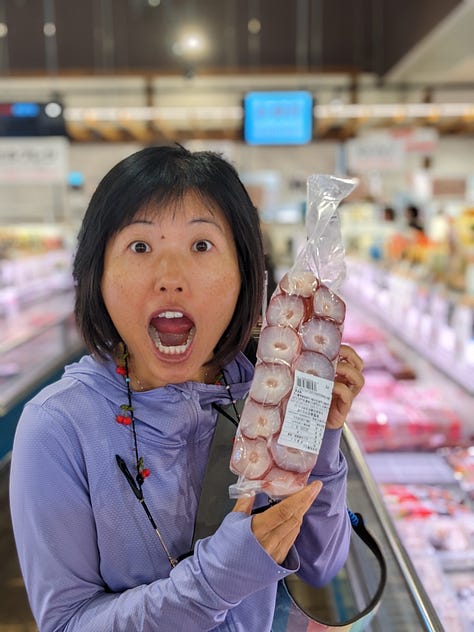
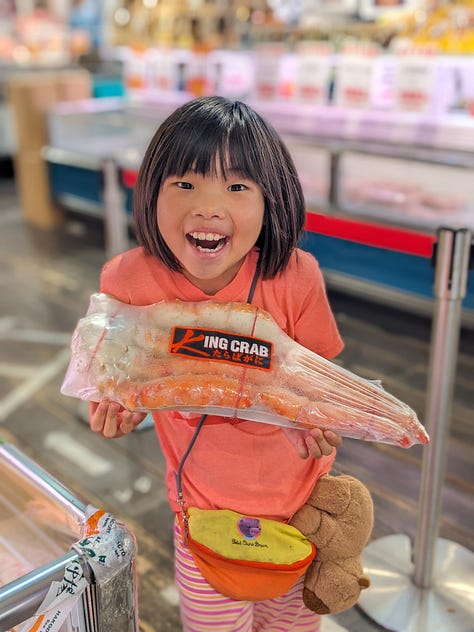
Eventually we tire from the day’s adventures, get some dinner, and walk back amongst the now lit up buildings. It’s so beautiful here.
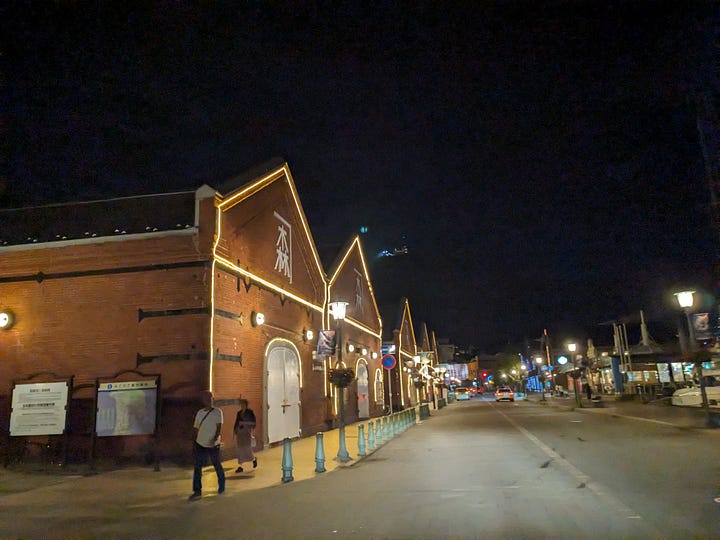

Goryokaku Fort - aka Kirby’s castle
The next day we head to the Goryokaku Fort, a star-shaped fortress. The way to see the fort is to ride up a tower built next to it so you can see the star shape. Many fortresses of this era are star shaped, but this one has a moat all around it, making the edges rounded. I played a video game called Kirby with Papa Bear when we were dating. And the star is a huge theme in the game. Kirby often inhales enemies, and when he spits them out, they become star-shaped projectiles that he can use to attack enemies. The fort’s star-shaped and rounded corners match the iconic star in the Kirby game exactly. The castle is also famous for turning completely pink during pink cherry blossom season. Kirby is pink. I’m surprised they don’t have Kirby as their ambassador!


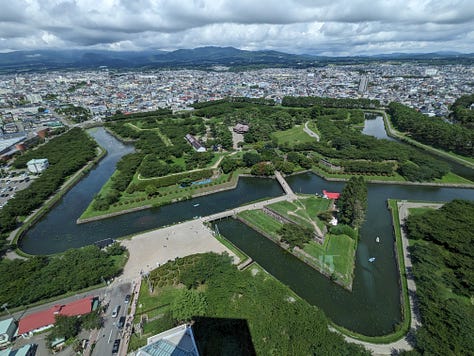

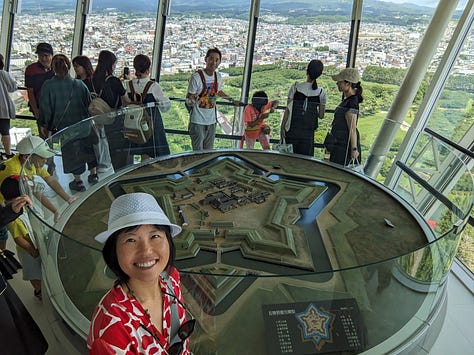

The tower has a museum inside explaining its history. The Goryokaku Fort is another testament to Hakodate’s historical significance. The Goryokaku Fort saw action during the Boshin War (1868-1869), which was a civil war between the samuri to the Tokugawa shogunate (and those supporting the newly established Meiji government. This is near the end of the samurai era.
After the Tokugawa shogunate fell, remnants of its loyal forces and samurais, led by Enomoto Takeaki, retreated to Hokkaido and established a breakaway republic. The Republic of Ezo was declared in December 1868 with Enomoto Takeaki as its president. Thus making Hokkaido independent from the rest of Japan. We find his statue in the tower.
However, the republic came to an end in May 1869, lasting only seven months, when the forces of the Meiji government from the Honshu defeated the Ezo forces at the Battle of Hakodate and captured Goryokaku Fort, leading to Enomoto's surrender. Pretty cool for Enomoto to get a statue for only 7 months of rule though, right? We think Hokkaido is proud to have been independent, if only for 7 months, thus still honor this very transient ruler.
The tower and the forts are both amazing to see, we also very much enjoy the gift shop. Normally not a gift shop person, I visit every gift shop in Hakodate hoping to find the right squid souvenir. And it is here that I finally find the one, and it’s a squid manhole cover towel. It combines my love of squid with my love of manhole covers. It’s definitely a keeper.
As a loyal documenter of manholes of Japan, post coming soon, I have already found this very manhole cover design before today. I was very excited at the time to discover a squid themed manhole, stopping in the middle of the street to capture it.
But discovering the towel at the gift shop did two things. 1) It tells me that I’m not alone in the love for Japanese manhole covers. and 2) the Squad manhole cover has a colored version. Now I have a new wish - to find the colored Squid Manhole. Searching on the internet yielded surprisingly no information. So we’ll have to see if we get lucky.
Next Papa Bear terrorize some stuffed birds by pretending to eat them, and I find a stuffed bear holding a squid instead of the classic salmon in its mouth. Keeper.
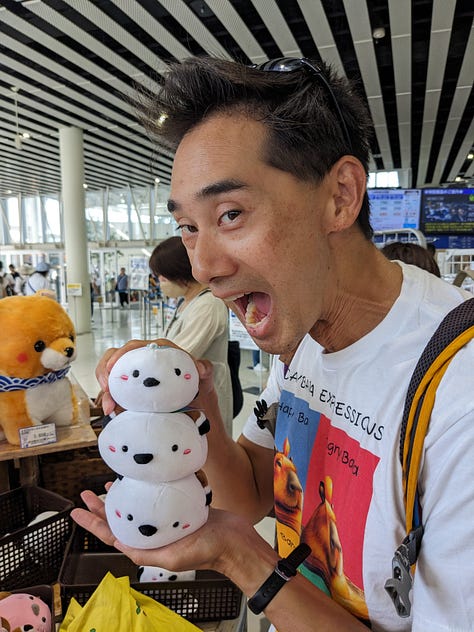
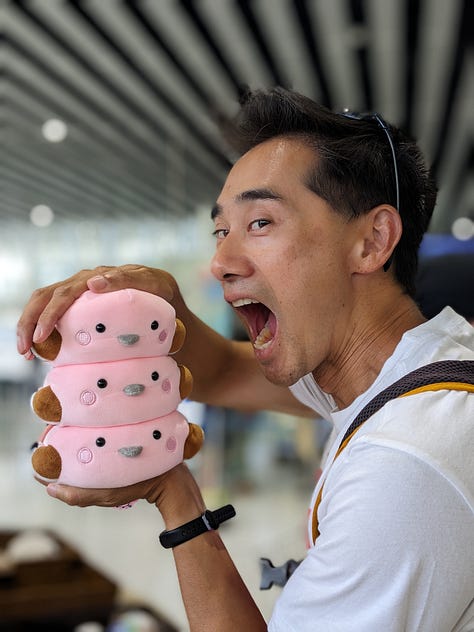
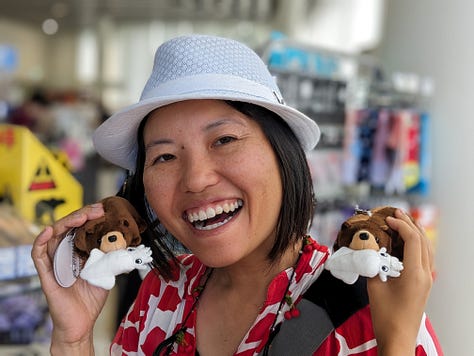
After leaving the gift shop we walk by the lobby and discover some familiar characters. Who are these characters? Where have I seen them? Remember Mt Hakodate with the snack area and the view? Turns out they are in the continuous advertisement we watched while sitting there. Advertising works. They were pushing that anime so hard because the show is based in Hakodate! It even features a scene “filmed” at the Fort while it’s pink and in bloom. That scene I remember from the ad!


The Negative Entrance fee
Next we cross to street to a a small maritime museum nearby called the Hakodate City Northern Pacific Fishery Document Museum (函館市北洋資料館). Yes that’s a mouthful. This museum is dedicated to the history of the northern Pacific fishing industry, including the city’s rich fishing traditions and its role in Hokkaido's maritime history.
Turns out the cost of entrance is lower than the cost of parking to see the Fort, and they validate for parking. So for our visit, we paid negative dollars. Wow!
The museum features exhibits on various fishing techniques, the lives of fishermen, and the types of fish commonly caught in the northern Pacific. We learn that since Hokkaido borders islands of Russia, their fisherman fish in the same waters.
The museum has English placards, very rare for museums in Japan. We are the only guests during our visit, and one of the museum curators follow us around in broken English to try and explain things to us. He’s very enthusiastic about maritime history!
The most surprising part is the ride. You heard it right, there’s a ride in this little museum! First you get into a room where it’s decorated like you are on the bridge of a fishing vessel. Then they close the doors, the lights go dim and room starts tiling and pitching, as if you’re at sea. The sound of a storm comes, and you can see through the windows a movie of the storm. It’s very realistic, and does the job of making me feel a little seasick. Luckily we survive this storm. But the fisherman at sea risk their lives on every trip to bring food home.
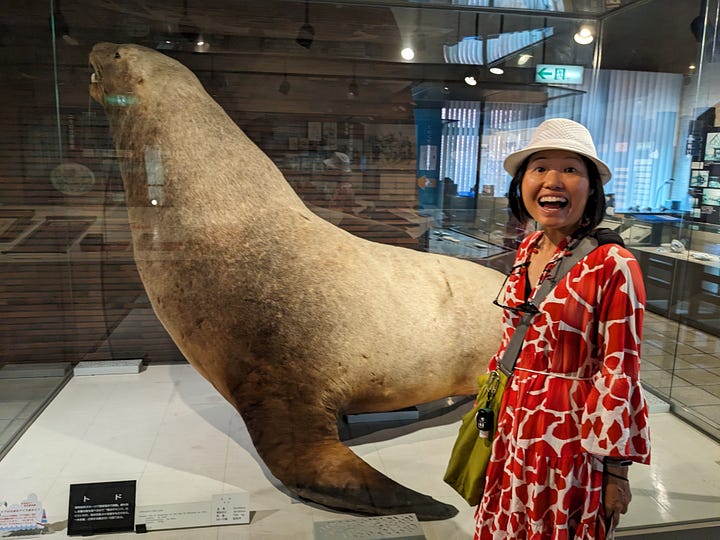

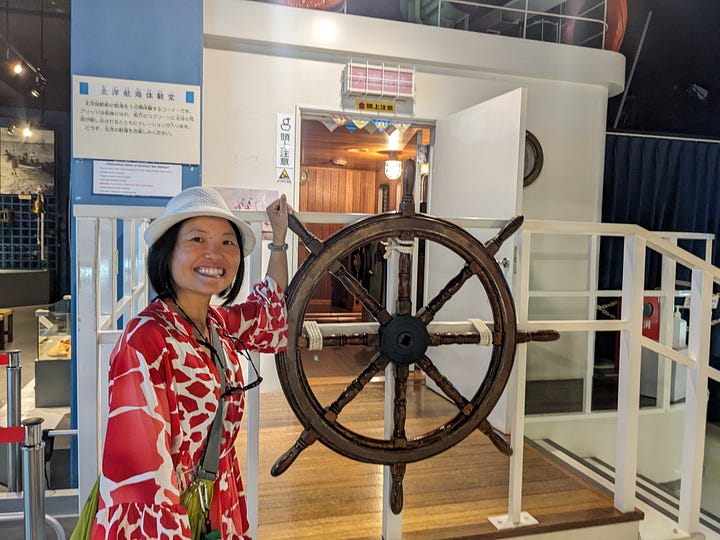
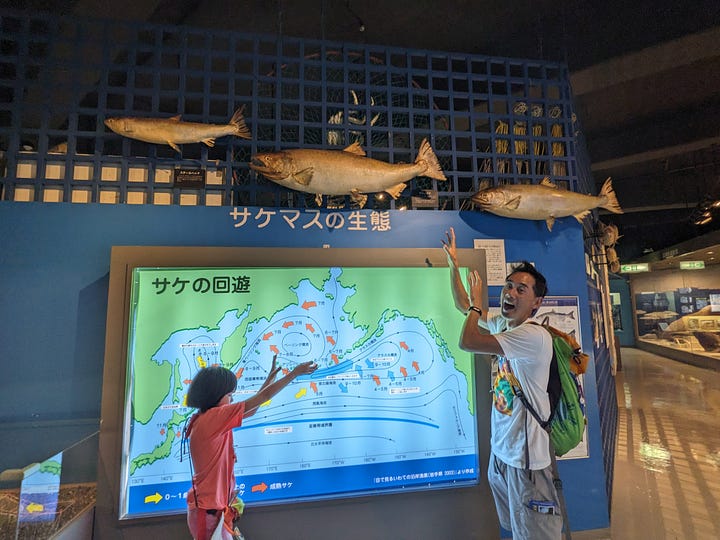
After the ride, we enjoy the little models of boats and their net networks below for catching various types of fish. Then we look at the little models of modern fishing vessels, many of which as an entire cannery built into the vessel! No wonder cannery buildings are now defunct everywhere, while we are still eating canned fish. They are canning directly on the boat now! I did not know this before. This is a museum really worth visiting.
Phew what a long post already, I’ll write more about Hakodate Part 2 in the next post. Stay tuned!






